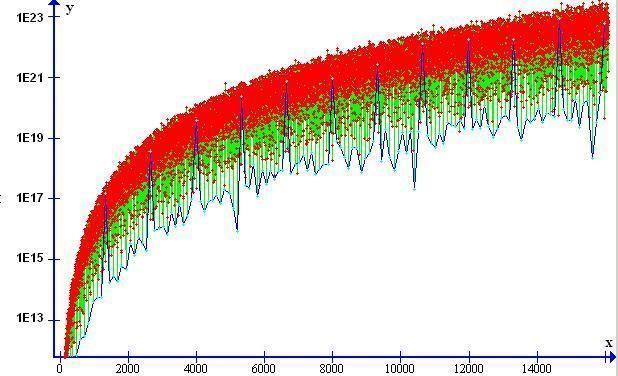 | ||
The Ramanujan tau function, studied by Ramanujan (1916), is the function
Contents
where
Values
The first few values of the tau function are given in the following table (sequence A000594 in the OEIS):
Ramanujan's conjectures
Ramanujan (1916) observed, but did not prove, the following three properties of
The first two properties were proved by Mordell (1917) and the third one, called the Ramanujan conjecture, was proved by Deligne in 1974 as a consequence of his proof of the Weil conjectures (specifically, he deduced it by applying them to a Kuga-Sato variety).
Congruences for the tau function
For k ∈ Z and n ∈ Z>0, define σk(n) as the sum of the k-th powers of the divisors of n. The tau function satisfies several congruence relations; many of them can be expressed in terms of σk(n). Here are some:
-
τ ( n ) ≡ σ 11 ( n ) mod 2 11 for n ≡ 1 mod 8 -
τ ( n ) ≡ 1217 σ 11 ( n ) mod 2 13 for n ≡ 3 mod 8 -
τ ( n ) ≡ 1537 σ 11 ( n ) mod 2 12 for n ≡ 5 mod 8 -
τ ( n ) ≡ 705 σ 11 ( n ) mod 2 14 for n ≡ 7 mod 8 -
τ ( n ) ≡ n − 610 σ 1231 ( n ) mod 3 6 for n ≡ 1 mod 3 -
τ ( n ) ≡ n − 610 σ 1231 ( n ) mod 3 7 for n ≡ 2 mod 3 -
τ ( n ) ≡ n − 30 σ 71 ( n ) mod 5 3 for n ≢ 0 mod 5 -
τ ( n ) ≡ n σ 9 ( n ) mod 7 for n ≡ 0 , 1 , 2 , 4 mod 7 -
τ ( n ) ≡ n σ 9 ( n ) mod 7 2 for n ≡ 3 , 5 , 6 mod 7 -
τ ( n ) ≡ σ 11 ( n ) mod 691.
For p ≠ 23 prime, we have
-
τ ( p ) ≡ 0 mod 23 if ( p 23 ) = − 1 -
τ ( p ) ≡ σ 11 ( p ) mod 23 2 if p is of the form a 2 + 23 b 2 -
τ ( p ) ≡ − 1 mod 23 otherwise .
Conjectures on τ(n)
Suppose that
Lehmer (1947) conjectured that
